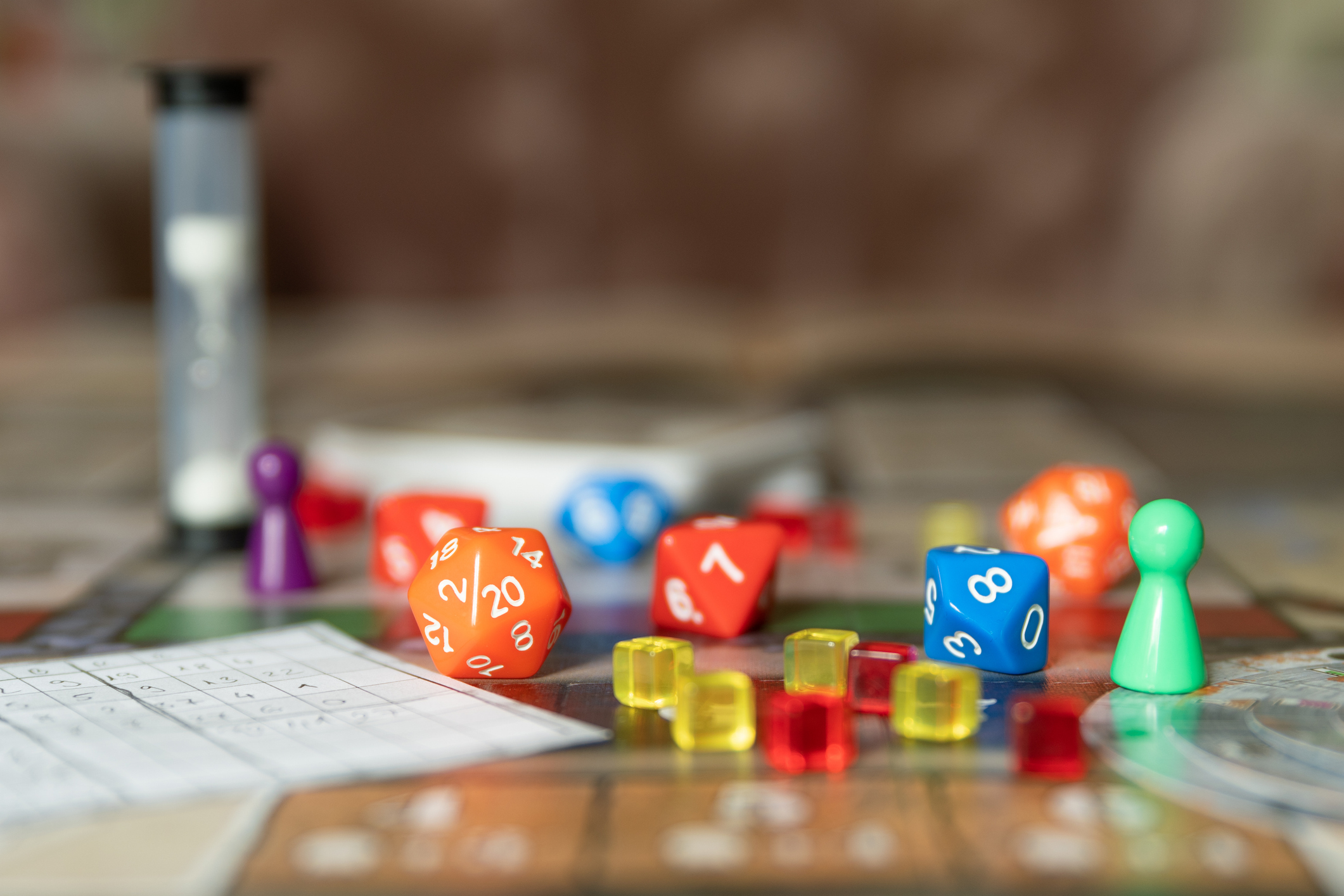Our Blogs
Preview of Gen Con 2024: Scheduled Events, Presenters, and Highlights
As Gen Con 2024 approaches, we can't contain our excitement to see what's new in tabletop gaming. Game Brands is going to be in Indianapolis for Gen Con Indy from August 1-4, 2024, and this year's convention promises a fantastic lineup of events, presenters, and activities. Here's a detailed preview of what we're looking forward to at Gen Con 2024.
Key Events and Highlights
Game Sessions and Tournaments
Gen Con 2024 will feature thousands of game sessions across a wide variety of genres. Highlights include:
- Dungeons & Dragons Epic Events: There are multiple large-scale one-shot D&D sessions, including a special adventure written exclusively for Gen Con 2024. If you're in, make sure to roll up a character!
- Magic: The Gathering Tournaments: Competitive play will include a Grand Prix event and draft tournaments. There will also be casual play opportunities; Game Brands is looking forward to bringing some EDH decks and getting some good spellslinging in.
- Board Game Marathons: Popular titles such as "Gloomhaven," "Wingspan," and "Terraforming Mars" will have dedicated play areas, with special sessions for new expansions and releases. If you've been looking to try these out before getting your hands on a copy, now's the perfect time!
- Other Sanctioned Tournaments: MTG and D&D aren't the only official tournament events to look forward to. If you're into Fantasy Flight Games' Star Wars Unlimited or Restoration Games' Unmatched, Gen Con is hosting official tournaments for those as well.
Workshops and Panels
The convention will host numerous workshops and panels led by industry experts. Notable sessions include:
- Game Design Workshops: Led by renowned designers such as Rob Daviau (creator of "Pandemic Legacy") and Elizabeth Hargrave (designer of "Wingspan"), these workshops will cover topics from game mechanics to narrative development. If you're a newbie game developer, sign up for these ahead of time to find out what you need to know!
- Publishing and Marketing Panels: The hardest part of getting a new board game out into the world is the marketing. At this panel, industry leaders from publishers like Wizards of the Coast and Asmodee will discuss the latest trends in game publishing and effective marketing strategies.
- Diversity in Gaming: As tabletop gaming's audience expands, so too do its designers. Gen Con 2024 features panels addressing inclusivity and representation in the gaming industry, featuring speakers like Tanya DePass (founder of I Need Diverse Games) and Ajit George (co-writer of "Journey Through the Radiant Citadel").
Special Presentations and Keynotes
Gen Con 2024 will feature special presentations and keynote addresses, including:
- Opening Keynote: Given by Gen Con founder Peter Adkison, reflecting on the convention’s history and future.
- Industry Trends: A keynote by Eric Lang, an influential game designer, discussing the future of tabletop gaming and emerging trends.
- Game Announcements: Major publishers will reveal new game titles and expansions during exclusive presentations. Be sure to check out Restoration Games' keynote for an announcement of their newest license!
Notable Presenters and Guests
Game Designers and Developers
- Matt Mercer: The renowned Dungeon Master of "Critical Role" will host several live-play sessions and panels. If you're looking to learn to DM, these are events you won't want to miss.
- Isaac Childres: The designer of "Gloomhaven" will lead discussions on complex game design and the development of the "Gloomhaven" universe.
- Jamey Stegmaier: The founder of Stonemaier Games will present on crowdfunding strategies and community engagement. Stonemaier is renowned for their pioneering work in digital marketing, so if you're struggling with getting traction online, you'll need this presentation.
Authors and Artists
- R.A. Salvatore: Yes, that R.A. Salvatore. The acclaimed author will discuss his work on "The Legend of Drizzt" series and his contributions to D&D lore and the Forgotten Realms.
- Lena Richter: An artist known for her work in games like "Root" and "Fort," will showcase her artwork and participate in a live art demonstration which should be a treat for all artists and art fans.
Industry Professionals
- Rosie Games Panel: Representatives from Rosie Games, known for innovative board game publishing, will discuss new projects and industry innovations.
- Kickstarter Experts: A panel featuring successful Kickstarter campaigners sharing insights on running effective crowdfunding campaigns. If you're new to digital marketing, this one is a must.
Interactive Experiences
Exhibitor Hall
The exhibitor hall this year will feature over 500 exhibitors, offering a mix of well-established publishers and indie developers. Highlights include:
- Game Demos: Attendees can try out new and upcoming games at demo booths. This is where I first tried out Ares Games' Sword and Sorcery last year, and I'm eager to see what else is up for trying!
- Exclusive Merch: Limited edition items, including game expansions, collectibles, and apparel, will be available. If you're a Funko Pop collector, you won't want to miss their booth!
- Meet-and-Greets: Opportunities to meet designers, artists, and authors for signings and photo ops. Fan of Ginny Di, or want to get some signed art from Naomi Vandoren? This is your chance!
Playtesting and Prototyping
- Playtest Hall: A dedicated area where attendees can playtest prototypes from emerging designers and provide feedback. This was my favorite part of the Con last year, and I'm eager to see what's new this year!
- Prototype Presentations: Sessions where designers present their upcoming projects and receive live feedback from industry experts and attendees. If you're a game designer, this is your chance to get professional feedback, so sign up now!
Community Events
- Cosplay Contest: Featuring elaborate costumes from various games, judged by a panel of professional cosplayers. As avid cosplayers ourselves, we can't wait to see what makes it onto the floor this year.
- Gen Con Dance: An after-hours event with themed music and entertainment. Make friends, network, and just hang out!
- Charity Events: This year includes a charity auction with rare and unique gaming items, and a charity game night supporting local organizations for the Indianapolis area.
Are You Excited Yet?
We are! Gen Con 2024 promises to deliver an exceptional experience, with a massive lineup of game sessions, workshops, and presentations. That's not even speaking about the incredible guests and the industry professionals offering valuable insights and networking opportunities. Whether you're a seasoned gamer, a budding designer, or a curious newcomer, Gen Con 2024 is sure to be an event you won't forget.
Analyzing the Leading Game Table Manufacturers
Brunswick Billiards
Brunswick Billiards, founded in 1845, is one of the oldest and most reputable names in the game table industry. Known primarily for their high-quality pool tables, Brunswick has a long-standing reputation for craftsmanship and durability.Strengths:
- Heritage and Expertise: With over 175 years of experience, Brunswick has honed its production techniques, ensuring high standards of quality and consistency.
- Innovative Design: The company regularly introduces new designs that blend traditional aesthetics with modern functionality, appealing to a broad customer base.
- Comprehensive Product Line: Brunswick offers a wide range of products, including pool tables, foosball tables, shuffleboard tables, and accessories, catering to various customer needs and preferences.
Imperial International
Imperial International is a leading wholesaler of billiard and game room products. Established in 1955, the company has built a strong presence in both residential and commercial markets.Strengths:
- Diverse Offerings: Imperial International provides a broad array of game tables, including pool, foosball, air hockey, and multi-game tables, as well as a variety of accessories.
- Strategic Partnerships: The company collaborates with major brands and distributors, enhancing its market reach and product availability.
- Quality and Value: Imperial International balances quality with affordability, making their products accessible to a wide range of consumers without compromising on performance.
Joola
Joola, established in 1952, is renowned for its high-quality table tennis tables and equipment. The company has a strong presence in both professional and amateur table tennis markets.Strengths:
- Professional Endorsements: Joola’s products are frequently used in international competitions, underscoring their quality and reliability.
- Research and Development: The company invests significantly in R&D, continually improving its products to meet the evolving needs of players.
- Customer Focus: Joola caters to both professional athletes and recreational players, offering products that range from entry-level to professional-grade tables and accessories.
Venture Shuffleboard
Venture Shuffleboard is a leading manufacturer of premium shuffleboard tables. Known for their commitment to craftsmanship, Venture has been producing high-quality shuffleboard tables since 1997.Strengths:
- Artisanal Craftsmanship: Venture emphasizes hand-crafted quality, using high-grade materials and meticulous production techniques to ensure superior product performance.
- Customization: The company offers extensive customization options, allowing customers to tailor tables to their specific preferences and decor.
- Specialized Focus: By focusing solely on shuffleboard tables, Venture has developed deep expertise and a strong reputation in this niche market.
Stiga
Stiga is a well-known manufacturer of table tennis tables and equipment, with a history dating back to 1944. The company is recognized for its innovative products and commitment to quality.Strengths:
- Innovation: Stiga regularly introduces new technologies and designs that enhance the playing experience, such as advanced playing surfaces and robust table frames.
- Global Reach: The company has a strong international presence, supplying products to a global market and participating in numerous international sporting events.
- Broad Product Range: Stiga offers a wide variety of table tennis tables, from compact models for small spaces to professional-grade tables for competitive play.
Fat Cat by GLD Products
Fat Cat, a brand under GLD Products, offers a range of game tables including pool tables, air hockey, and multi-game tables. Known for their affordability and versatility, Fat Cat products are popular among home entertainment enthusiasts.Strengths:
Versatility: Fat Cat specializes in multi-game tables that combine several games into one unit, providing excellent value and space-saving benefits. Affordability: The brand targets budget-conscious consumers, offering reasonably priced products without sacrificing essential features and quality. Customer Support: Fat Cat is known for its responsive customer service, providing support and assistance to ensure customer satisfaction.6 Challenges Facing Manufacturers of Pool Table Equipment
1. Market Saturation and Competition
The Challenge:
The pool table equipment market is highly competitive, with numerous established brands and a significant number of new entrants. This saturation makes it difficult for manufacturers to differentiate their products and maintain market share.Strategic Response:
- Innovation and Differentiation: Investing in R&D to create unique features, such as advanced materials, ergonomic designs, or smart technology integration, can help products stand out.
- Brand Positioning: Focusing on branding strategies that highlight quality, heritage, or unique selling propositions (USPs) can create a stronger market presence.
- Niche Markets: Identifying and targeting niche segments, such as luxury home markets, professional tournaments, or educational institutions, can open new avenues for growth.
2. Rising Production Costs
Challenge:
The cost of raw materials, labor, and transportation has been increasing. High-quality wood, slate, and specialty fabrics are essential for premium pool tables but have seen price hikes, impacting the overall cost structure.Strategic Response:
- Supply Chain Optimization: Building relationships with reliable suppliers and exploring bulk purchasing agreements can mitigate raw material costs. Diversifying suppliers to include international options may also provide cost benefits.
- Lean Manufacturing: Implementing lean manufacturing principles to reduce waste and improve efficiency can help control production costs. Automation and advanced manufacturing technologies can also play a crucial role.
- Cost-Effective Materials: Researching alternative materials that offer similar quality at lower costs can provide a competitive edge without compromising product standards.
3. Changing Consumer Preferences
Challenge:
Consumer preferences are shifting towards multi-functional and space-saving furniture, particularly in urban settings where space is at a premium. Traditional, bulky pool tables may not fit into modern living spaces.Strategic Response:
- Product Diversification: Developing multi-functional pool tables that double as dining tables or desks can appeal to space-conscious consumers. Compact and modular designs can also cater to this trend.
- Customization: Offering customizable options that allow consumers to choose colors, finishes, and additional features can attract a broader audience. Personalization adds perceived value and can justify higher price points.
- Digital Integration: Incorporating technology, such as app-controlled lighting or scoring systems, can attract tech-savvy consumers and provide a modern twist to traditional pool tables.
4. Distribution and Logistics Challenges
Challenge:
Pool tables are large, heavy items that require careful handling and specialized transportation. The logistics of shipping and installation can be complex and costly, affecting profit margins and customer satisfaction.Strategic Response:
- Logistics Partnerships: Partnering with logistics companies that specialize in handling large, delicate items can ensure efficient and safe transportation. These partnerships can also offer better rates and service consistency.
- Local Manufacturing and Assembly: Establishing local assembly plants or partnering with regional manufacturers can reduce shipping distances and costs. This approach also allows for quicker delivery times and better customer service.
- Enhanced Packaging Solutions: Investing in robust, sustainable packaging solutions can protect products during transit and reduce damage rates, thereby lowering return and replacement costs.
5. Economic Fluctuations
Challenge:
The pool table industry, like many luxury goods sectors, is susceptible to economic downturns. During periods of economic uncertainty, consumers and businesses may cut back on non-essential expenditures, including high-end pool tables.Strategic Response:
- Flexible Pricing Strategies: Implementing flexible pricing models, such as financing options or seasonal discounts, can make products more accessible during economic downturns.
- Product Line Diversification: Developing a range of products at different price points can cater to both budget-conscious consumers and those looking for premium options.
- Targeting B2B Markets: Focusing on business-to-business (B2B) markets, such as hotels, bars, and corporate offices, can provide a steadier revenue stream. These entities may continue to invest in entertainment amenities regardless of broader economic conditions.
6. Sustainability Concerns
Challenge:
There is growing consumer awareness and demand for sustainable and environmentally-friendly products. The traditional manufacturing processes for pool tables can be resource-intensive and may not align with these evolving consumer values.Strategic Response:
- Sustainable Materials: Sourcing sustainable and certified materials, such as FSC-certified wood or recycled metals, can appeal to eco-conscious consumers.
- Eco-Friendly Manufacturing: Implementing eco-friendly manufacturing processes, including energy-efficient production and waste reduction practices, can enhance brand reputation and comply with regulatory standards.
- Transparent Practices: Communicating sustainability efforts transparently through marketing and product labeling can build trust and loyalty among consumers who prioritize environmental responsibility.
What Does This Mean for You?
Though the pool table equipment industry faces significant challenges, from market saturation and rising production costs to changing consumer preferences and logistics complexities, these challenges are surmountable. By adopting innovative strategies, focusing on efficiency, and aligning with consumer trends, manufacturers can navigate these hurdles and position themselves for long-term success. Embracing digital transformation, sustainability, and strategic partnerships will be crucial in maintaining competitiveness and meeting the evolving demands of the market.The Family Entertainment Business: Why Do You Need Digital Marketing?
Changing Consumer Behavior
One of the primary reasons family entertainment businesses need to embrace digital marketing is the significant shift in consumer behavior. Today's consumers are more digitally connected than ever before, relying on online platforms for information, entertainment, and social interaction. The prevalence of smartphones, social media, and online review sites means that potential customers are forming opinions and making decisions based on digital content.Impact:
- Visibility: Digital marketing ensures that businesses are visible where their customers spend a considerable amount of time—online. Without a strong online presence, family entertainment businesses risk being overlooked.
- Engagement: Engaging with customers through social media, blogs, and other digital channels allows businesses to build relationships, foster loyalty, and drive word-of-mouth promotion.
Cost-Effectiveness and Measurability
Traditional marketing methods, such as print ads, TV commercials, and billboards, can be expensive and difficult to measure in terms of effectiveness. Digital marketing, on the other hand, offers cost-effective solutions with precise metrics for tracking performance.Impact:
- Budget Efficiency: Digital marketing campaigns can be scaled according to budget constraints, allowing smaller businesses to compete with larger ones. Pay-per-click (PPC) advertising, social media promotions, and email marketing are cost-effective methods to reach a broad audience.
- Analytics: Tools like Google Analytics, social media insights, and email marketing metrics provide detailed data on campaign performance. This data-driven approach enables businesses to refine their strategies, optimize spending, and improve return on investment (ROI).
Targeted Marketing and Personalization
Digital marketing allows for highly targeted and personalized campaigns. By leveraging data analytics and customer segmentation, businesses can tailor their marketing efforts to specific demographics, interests, and behaviors.Impact:
- Relevance: Targeted marketing ensures that promotional messages are relevant to the audience, increasing the likelihood of engagement and conversion. For example, amusement parks can target families with young children during school holidays, while laser tag companies can reach out to corporate groups for team-building exercises.
- Customer Experience: Personalization enhances the customer experience by delivering content and offers that resonate with individual preferences. This can lead to higher satisfaction and loyalty.
Enhanced Customer Interaction and Feedback
Digital marketing platforms facilitate two-way communication between businesses and customers. Social media, online reviews, and customer surveys provide opportunities for businesses to interact with their audience, gather feedback, and address concerns promptly.Impact:
- Customer Insights: Regular interaction with customers allows businesses to gain valuable insights into their preferences, needs, and pain points. This information can guide product development, service improvements, and marketing strategies.
- Reputation Management: Actively managing online reviews and social media comments helps businesses build and maintain a positive reputation. Responding to feedback, both positive and negative, demonstrates commitment to customer satisfaction and transparency.
Adapting to Mobile Usage
With the majority of consumers accessing the internet via smartphones, mobile optimization is crucial for digital marketing success. Family entertainment businesses need to ensure their websites, booking systems, and digital content are mobile-friendly.Impact
- User Experience: A mobile-optimized website provides a seamless user experience, which is essential for attracting and retaining customers. Slow-loading pages or difficult navigation can lead to high bounce rates and lost opportunities.
- Accessibility: Mobile-friendly booking and payment systems make it easier for customers to make reservations, purchase tickets, and access services on-the-go, increasing convenience and sales.
Leveraging Social Media Influence
Social media platforms like Facebook, Instagram, and TikTok have become powerful tools for reaching and engaging with audiences. Family entertainment businesses can use these platforms to showcase their offerings, share user-generated content, and run promotional campaigns.Impact:
- Brand Awareness: Social media presence increases brand visibility and helps attract new customers. Engaging content, such as behind-the-scenes videos, customer testimonials, and interactive posts, can boost brand awareness and interest.
- Community Building: Social media allows businesses to build a community around their brand. Encouraging customers to share their experiences and participate in online discussions fosters a sense of belonging and loyalty.
Future-Proofing the Business
The adoption of digital marketing is not just about current trends but also about future-proofing the business. As technology continues to advance, businesses that are already well-versed in digital marketing will be better positioned to adapt to new tools and platforms.Impact:
- Innovation: Staying updated with digital marketing trends encourages innovation and keeps businesses ahead of the competition. Embracing new technologies, such as augmented reality (AR) experiences or AI-driven customer service, can enhance the overall customer experience.
- Sustainability: A strong digital presence ensures long-term sustainability by reaching new generations of tech-savvy consumers who prioritize digital interactions.
What Does This Mean for My Business?
For family entertainment businesses, adopting digital marketing is no longer optional but essential. The changing consumer behavior, cost-effectiveness, targeted marketing capabilities, enhanced customer interaction, mobile optimization, social media influence, and future-proofing benefits make digital marketing a critical component of business strategy. By leveraging these digital tools and platforms, family entertainment businesses can enhance their visibility, engagement, and overall success in an increasingly competitive market.Analyzing the Challenges in the Bowling Lane Industry
The bowling lane industry, once a staple of American recreational culture, has faced significant challenges over the past few decades, which only intensified in the last four years with the advent of the COVID-19 pandemic. There are a lot of reasons for these issues, including:
- Shifting consumer preferences
- Economic pressures
- The need for modernization
In this post, Game Brands explores these key challenges and considers strategies that industry members might want to try to help boost their revenues.
1. Shifting Consumer Preferences
One of the biggest issues for bowling lanes, and indeed the entire family entertainment industry, is the shift in consumer preferences towards digital entertainment options. With video games and streaming services now more available than ever (and usually much less expensive than a day out), the appeal of traditional physical activities like bowling has begun to drop. Millenials, Gen Z, and Gen Alpha in particular tend to prefer activities that offer quicker gratification and social connectivity, which they can get easily through digital platforms.
Strategic Response:
To address this challenge, bowling alleys need to innovate and diversify their offerings. Incorporating modern entertainment elements such as arcades, VR experiences, and social gaming can attract younger customers. Additionally, integrating technology within the bowling experience, like automated scoring systems and interactive lanes, can enhance engagement.
2. Economic Pressures
Economic fluctuations have a significant impact on consumer's discretionary spending, which in turn affects the bowling industry. During economic downturns, consumers often cut back on non-essential spending, including leisure activities like bowling, while the aforementioned streaming services tend not to take as much of a hit. Moreover, the high operational costs associated with maintaining bowling alleys, such as real estate, equipment maintenance, and labor, exacerbate these pressures.
Strategic Response:
Bowling alley operators should focus on cost management and operational efficiency. Implementing energy-efficient systems, optimizing staffing levels, and exploring bulk purchasing agreements for supplies can help reduce costs. Additionally, offering flexible pricing models, such as off-peak discounts and membership programs, can encourage consistent patronage even during economic downturns.
3. Aging Infrastructure
Many bowling alleys were established several decades ago and now face the issue outdated facilities and equipment, which not only detract from the customer experience but also lead to higher maintenance costs. Without significant investment in modernization, these facilities risk becoming obsolete.
Strategic Response:
Investment in upgrading facilities is crucial. This includes:
- Refurbishing bowling lanes
- Updating scoring systems
- Enhancing the overall aesthetic appeal of the alleys
Seeking funding through loans, grants, or partnerships can provide the necessary capital for these upgrades. Moreover, modernizing facilities can be positioned as a long-term investment, potentially increasing customer satisfaction and repeat business.
4. Competition from Alternative Entertainment
The rise of alternative family entertainment options, such as escape rooms, trampoline parks, and immersive cinema experiences, has intensified competition. These alternatives often offer novel and exciting experiences that can overshadow traditional or "less cool" activities like bowling.
Strategic Response:
The solution here is much the same as the solution to the preference for digital experience: bowling alleys should consider diversifying their entertainment options to remain competitive and creating multi-entertainment complexes that include a variety of attractions can draw in a wider audience.
However, in terms of remaining competitive with other family entertainment options specifically, you'd want to expand in a different direction: lean into the things that only a bowling alley can do. Hosting themed events, leagues, and tournaments can differentiate bowling alleys from other entertainment venues, as an escape room can't exactly have a "league."
Furthermore, partnering with local businesses and community organizations for joint promotions and events can help drive traffic.
5. Marketing and Engagement
Traditional marketing approaches may no longer be sufficient to attract new customers and retain existing ones. The rise of social media and digital marketing has transformed how businesses reach and engage with their audience. Bowling alleys that fail to adapt to these changes may struggle to maintain visibility and relevance.
Strategic Response:
Developing a robust digital marketing strategy is essential. This includes maintaining an active presence on social media platforms, engaging with customers through targeted campaigns, and utilizing data analytics to understand customer preferences and behaviors. Additionally, creating compelling content, such as videos and blogs showcasing the unique aspects of the bowling experience, can enhance online engagement.
6. Health and Safety Concerns
The COVID-19 pandemic has heightened awareness of health and safety concerns in public spaces, concerns which persist even as the pandemic becomes less immediate in the minds of patrons. Bowling alleys, with their high-touch surfaces and shared equipment, need to implement stringent health protocols to reassure customers and comply with regulatory requirements.
Strategic Response:
Adopting comprehensive health and safety measures is critical. This includes regular sanitation of equipment, enforcing social distancing guidelines, and providing hand sanitizing stations. Communicating these measures clearly to customers can build trust and confidence. Additionally, exploring options for contactless payment and online booking systems can minimize physical interactions.
What Does This Mean for my Bowling Alley?
The bowling lane industry faces a range of significant challenges, but these challenges aren't insurmountable. By diversifying entertainment offerings, modernizing facilities, optimizing operational efficiency, and leveraging digital marketing, lane owners can navigate these challenges effectively. Proactive adaptation and innovation are essential for the bowling lane industry to sustain its relevance and appeal in the evolving recreational landscape.
Navigating Challenges in the Board Game Industry
In an age dominated by virtual entertainment, the enduring appeal of board games might seem unexpected. Yet, despite these challenges the board game industry not only survives, but thrives, driven by a renewed interest in tangible, social experiences post-pandemic.
However, this renaissance has its own hurdles, and with the number of new games released every day, each hurdle can trip even the most experienced game maker. From supply chain complexities to shifting consumer expectations, the board game sector has to navigate a number of challenges.
Supply Chain and Manufacturing Challenges
One of the biggest obstacles for board game publishers is managing the necessary intricate supply chains and manufacturing processes. Unlike digital products, board games require physical components that can require services including:
- Printing
- Plastic and metal sculpting
- Painting
All of these need to be sourced globally, manufactured, and then distributed to retailers and customers worldwide. Issues such as material shortages, production delays, and shipping disruptions can significantly impact timelines and costs.
Overcoming these challenges demands proactive planning and adaptable strategies—you can't just assume that everything in the process will go right. This often creates higher manufacturing costs, which you may have to end up passing on to the product pricing.
Aggressively Competitive Markets
The resurgence of board games has led to a massive number of new titles entering the market every year. According to Board Game Geek, 2019 saw over 4.5 thousand new games published, and that number is only climbing.
Standing out in a such a crowded marketplace requires more than a compelling game concept; you need effective marketing, robust distribution channels, and substantial investments in artwork and production quality.
Established publishers may have the most shelf space at Target or Toys 'R' Us, but the still have to continuously innovate to just to keep their share of the market. Meanwhile, indie developers have to figure out how to get noticed among giants like Hasbro or Parker Bros. Crowdfunding platforms like Kickstarter have made funding access available to everybody, but that funding is dependent on its own form of marketing..
Hybrid Digital/Board Games
Though the board game industry traditionally screams "analog," many publishers have embraced digital transformation. Digital adaptations through apps or online platforms, such as online versions of Settlers of Catan, Magic the Gathering, and the advent of Roll20 offer new revenue streams and global accessibility. However, these adaptations blur the lines between traditional board games and video games, challenging the industry's identity and forcing less-established designers or publishers to make painful choices.
Then there's the hybrid models, which combining physical games with digital components. Formerly reserved for included DVD players, these new innovations are much more accessible than before, but fraught with issues. While these companion-app games can enhance gameplay and attract tech-savvy consumers or explain complicated rulesets, executing them effectively still requires you to market to board game consumers who may not want to need to download an app, or may be thinking, "can I still play the game if the company goes down and the app stops being maintained?"
Adapting to Evolving Consumer Preferences
Where before it was easy to sell new games as simply "Monopoly but the rules are slightly different," consumer preferences are evolving. Modern consumers seek diverse gaming experiences, from quick, casual games card-matching games to more immersive Euro-style simulation games. Publishers have to balance innovation with tradition to cater to both old guard players and people seeking a brand new board game experience.
The Influencer Experience
The influence of social media and online influencers has permanently reshaped game discovery and promotion. Getting on game shelves isn't enough; potential customers are going to be looking at their favorite board game reviewers or rankings lists on Board Game Geek. Positive reviews and endorsements can propel a game to success, while negative publicity spreads rapidly. Managing your company's online reputation and fostering community engagement are now integral to maintaining relevance and success in an industry where media personalities are increasingly a necessary part of sales and marketing.
What Does This Mean for Publishers?
Though more people are buying board games than ever before, the industry itself now faces formidable challenges. With those challenges, however, come opportunities for growth and innovation.
By embracing technological advancements, diversifying offerings, and nurturing inclusive communities, the industry can build on its legacy while paving the way for an exciting future. As publishers, developers, and players collaborate, the future promises a vibrant landscape where creativity thrives and tabletop experiences continue to captivate enthusiasts worldwide.






